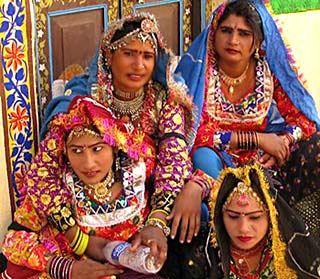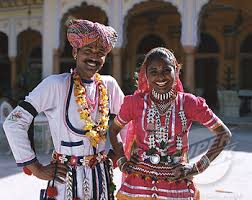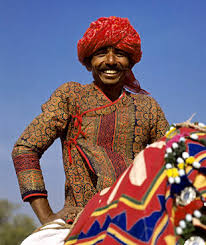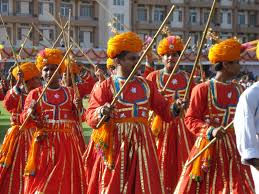source(google.com.pk)
Traditional Dress Of Rajasthan Biography
Vivid reds, pinks and greens splash across the desert breaking the monotony of the yellow sands; colored stones and tinsels splash their brilliant hues challenging the flaming sun; silver and brass jewellery tinkle and clink complementing the ancient folk songs drifting across Thar the with the arid scalding winds- welcome to vibrant Rajasthan. The costumes and dresses of the native Rajasthanis are a spectacular combination of cultural lineage and weather proof designing.
The garments are loose and flowing clothes and are generally cut out to cover up most of the body. This prevents sunburns resulting from direct exposure to the harsh rays. The textiles are mainly soft cottons that provide utmost comfort during the summer months. Winters too are extremely cold and woolen shawls, scarves and cloaks are draped by men and women to protect themselves from the merciless temperature falls. Maps Of India takes you through a journey across the various cultures and styles of Rajasthan dresses.
Women's Dresses:
The women dress in either sarees or ghaghra cholis. Sarees may be either cotton or silk and are generally embroidered. Colored stones, tinsels and silken threads are used to create beautiful floral patterns and traditional motifs and enhance the rich look of the saree. Depending on the economic ampleness of the family the embroidery or zari work may be done with golden and silver threads and semi precious gems may replace the showy colored stones. Tie and Dye, Bandhani and block printed textiles are the common choice.
However in the rural nooks of the state the women are still given to wearing long or short flowing and frilly skirts. Ghagras for daily use and Lehengas for more formal occasions are the norm. These are matched with blouses such as Kanchli or Kunchuki or Choli depending on the blouse length. The skirts are tied tightly around the waist and have a flaring width at their base. The Ghagras are generally short extending up to the calf while the Lehengas are longer and reach up to the ankles. The more formal occasions and prosperous households dictate increased width and more number of folds or pleats in the skirts. These Ghagras and Lehengas are also embroidered and decorated much in the same style as sarees are.
The Odhni is an integral part of the Rajasthani women's attire and deserves special mention. It is generally a long piece of cloth (generally 3 meters by 2 meters). Though usually teamed up with the Ghagra Choli or Lehengas, it is also worn over a saree on special ceremonious occasions. One end of it is tucked into the skirt or saree at the waist. It is draped gracefully across like a saree and taken to cover the head in a short veil. Odhni stands as a mark of respect and conformity to one’s traditions and the bridal Odhni is a piece of exquisitely hand embroidered attire treasured by every woman as long as she lives and used sparingly. The Muslim women of the state wear burkhas or traditional black veils.
Men's Attire:
Banda, Bugatari, Pachewara and Khol form the traditional costume of the rural men. A dhoti is a long white cloth skillfully worn around the waist and draped to form gracefully loose breeches. An Angrakhi or a Jhari is a jacket like garment worn to cover the upper body. The Angrakhi may be short frock styled known as ‘kamari angarakha’ or long knee length garments. A shawl or Dhabla compliments the men’s attire. Muslim men are given to wear Achkans and Kurtas. The kamarband or patka is a waistband (mostly simply a piece of cloth tied across the waist) that aids in holding a weapon or arm tucked into it.
The headgears of men are special and spectacular. Pencha, Sela, Saafa, Potia and Pagri are all an assortment of headgear sported by the men of the state. The Pagri is the most famous among these. It is usually 82 feet long and an 8 inch wide piece of cloth. It is used as a turban and the style of wearing it is influenced by the region, the climatic and socio economic status of the wearer. The natives of Udaipur, for example wear a flat turban while those from Jaipur sport slanting angular turbans. While those from Jodhpur, wear their Saafa (a shorter variety of turban) with curved bands to the front.
Royal Dressing:
The royals of the state had their own distinctive style of dressing. The turbans are larger and often have jewels or feathers attached to them to signify their stature. To tackle the mammoth task of tying the royal turbans, professional Pagribands were employed. Specialized departments such as Ranghkhana, the Chhapakhana and the Siwankhana were deployed by the princely states to attend to the dyeing, printing and tailoring of the textiles forming part of the royal wardrobe. The Toshakhanaand looked into the everyday attire of the royal family while the Kapaddwadra looked into their dresses on festive and formal occasions. The Rajputs, due to their close association with the Mughal courts adopted the Mughal styles of clothing and preferred richly embroidered brocades and silks from Benares. Exquisite Kashmir shawls and pashminas replaced the local Dhabla in their wardrobe.
Modern Tastes:
Modern tastes and dictates of the younger generations are governed by urban and western fashion trends. While the women fall prey to the lures of Salwar suits and western wear, men too seek the casual comfort of Shirts, T Shirts, Trousers and Jeans. The office-going younger lot conforms to the global norms of dressing and corporate etiquette










Traditional Dress Of Rajasthan Biography
Vivid reds, pinks and greens splash across the desert breaking the monotony of the yellow sands; colored stones and tinsels splash their brilliant hues challenging the flaming sun; silver and brass jewellery tinkle and clink complementing the ancient folk songs drifting across Thar the with the arid scalding winds- welcome to vibrant Rajasthan. The costumes and dresses of the native Rajasthanis are a spectacular combination of cultural lineage and weather proof designing.
The garments are loose and flowing clothes and are generally cut out to cover up most of the body. This prevents sunburns resulting from direct exposure to the harsh rays. The textiles are mainly soft cottons that provide utmost comfort during the summer months. Winters too are extremely cold and woolen shawls, scarves and cloaks are draped by men and women to protect themselves from the merciless temperature falls. Maps Of India takes you through a journey across the various cultures and styles of Rajasthan dresses.
Women's Dresses:
The women dress in either sarees or ghaghra cholis. Sarees may be either cotton or silk and are generally embroidered. Colored stones, tinsels and silken threads are used to create beautiful floral patterns and traditional motifs and enhance the rich look of the saree. Depending on the economic ampleness of the family the embroidery or zari work may be done with golden and silver threads and semi precious gems may replace the showy colored stones. Tie and Dye, Bandhani and block printed textiles are the common choice.
However in the rural nooks of the state the women are still given to wearing long or short flowing and frilly skirts. Ghagras for daily use and Lehengas for more formal occasions are the norm. These are matched with blouses such as Kanchli or Kunchuki or Choli depending on the blouse length. The skirts are tied tightly around the waist and have a flaring width at their base. The Ghagras are generally short extending up to the calf while the Lehengas are longer and reach up to the ankles. The more formal occasions and prosperous households dictate increased width and more number of folds or pleats in the skirts. These Ghagras and Lehengas are also embroidered and decorated much in the same style as sarees are.
The Odhni is an integral part of the Rajasthani women's attire and deserves special mention. It is generally a long piece of cloth (generally 3 meters by 2 meters). Though usually teamed up with the Ghagra Choli or Lehengas, it is also worn over a saree on special ceremonious occasions. One end of it is tucked into the skirt or saree at the waist. It is draped gracefully across like a saree and taken to cover the head in a short veil. Odhni stands as a mark of respect and conformity to one’s traditions and the bridal Odhni is a piece of exquisitely hand embroidered attire treasured by every woman as long as she lives and used sparingly. The Muslim women of the state wear burkhas or traditional black veils.
Men's Attire:
Banda, Bugatari, Pachewara and Khol form the traditional costume of the rural men. A dhoti is a long white cloth skillfully worn around the waist and draped to form gracefully loose breeches. An Angrakhi or a Jhari is a jacket like garment worn to cover the upper body. The Angrakhi may be short frock styled known as ‘kamari angarakha’ or long knee length garments. A shawl or Dhabla compliments the men’s attire. Muslim men are given to wear Achkans and Kurtas. The kamarband or patka is a waistband (mostly simply a piece of cloth tied across the waist) that aids in holding a weapon or arm tucked into it.
The headgears of men are special and spectacular. Pencha, Sela, Saafa, Potia and Pagri are all an assortment of headgear sported by the men of the state. The Pagri is the most famous among these. It is usually 82 feet long and an 8 inch wide piece of cloth. It is used as a turban and the style of wearing it is influenced by the region, the climatic and socio economic status of the wearer. The natives of Udaipur, for example wear a flat turban while those from Jaipur sport slanting angular turbans. While those from Jodhpur, wear their Saafa (a shorter variety of turban) with curved bands to the front.
Royal Dressing:
The royals of the state had their own distinctive style of dressing. The turbans are larger and often have jewels or feathers attached to them to signify their stature. To tackle the mammoth task of tying the royal turbans, professional Pagribands were employed. Specialized departments such as Ranghkhana, the Chhapakhana and the Siwankhana were deployed by the princely states to attend to the dyeing, printing and tailoring of the textiles forming part of the royal wardrobe. The Toshakhanaand looked into the everyday attire of the royal family while the Kapaddwadra looked into their dresses on festive and formal occasions. The Rajputs, due to their close association with the Mughal courts adopted the Mughal styles of clothing and preferred richly embroidered brocades and silks from Benares. Exquisite Kashmir shawls and pashminas replaced the local Dhabla in their wardrobe.
Modern Tastes:
Modern tastes and dictates of the younger generations are governed by urban and western fashion trends. While the women fall prey to the lures of Salwar suits and western wear, men too seek the casual comfort of Shirts, T Shirts, Trousers and Jeans. The office-going younger lot conforms to the global norms of dressing and corporate etiquette
Traditional Dress Of Rajasthan

Traditional Dress Of Rajasthan

Traditional Dress Of Rajasthan
Traditional Dress Of Rajasthan
Traditional Dress Of Rajasthan
Traditional Dress Of Rajasthan
Traditional Dress Of Rajasthan

Traditional Dress Of Rajasthan

Traditional Dress Of Rajasthan

Traditional Dress Of Rajasthan

Traditional Dress Of Rajasthan
No comments:
Post a Comment